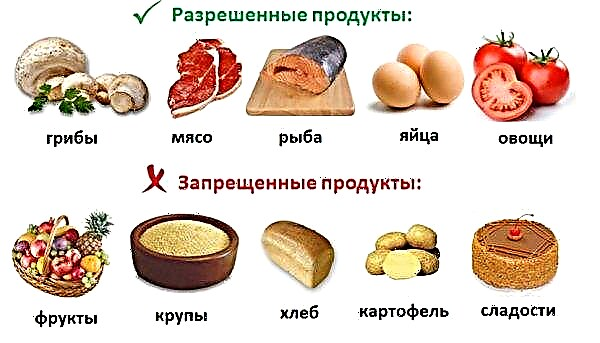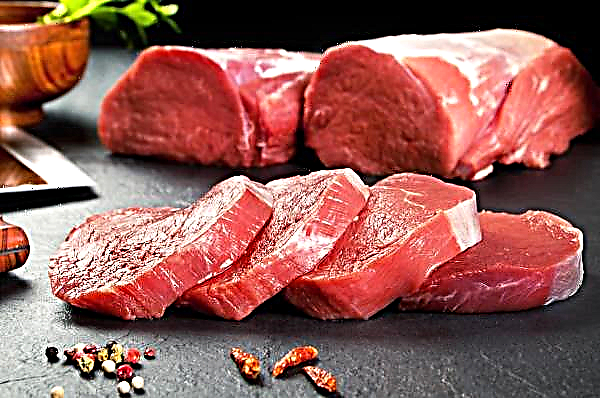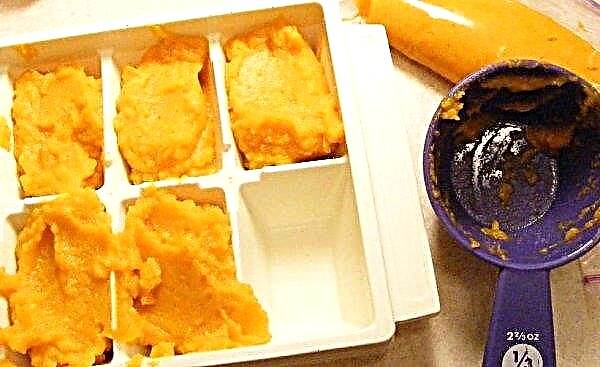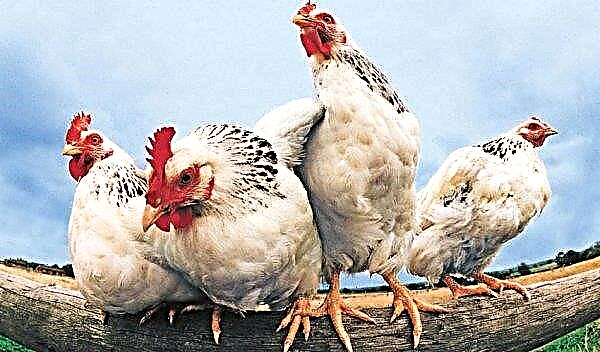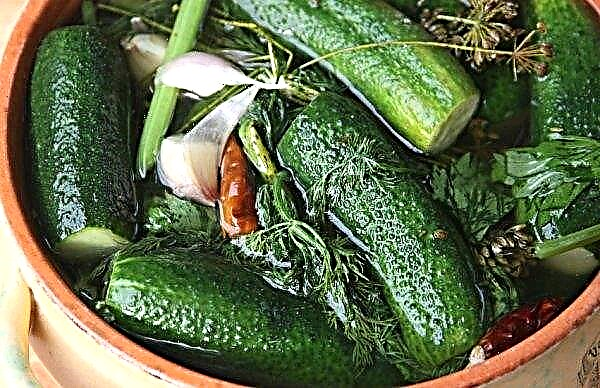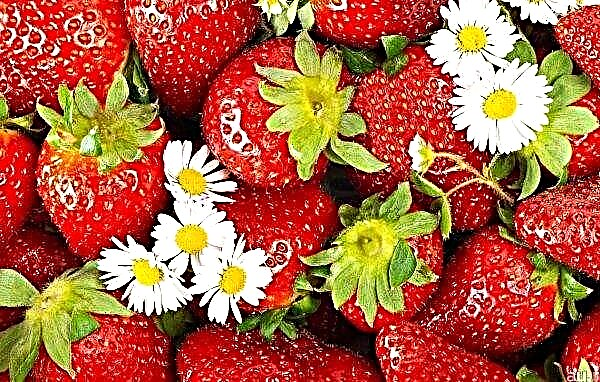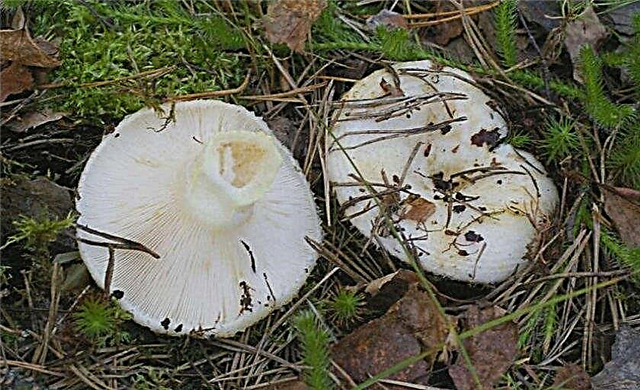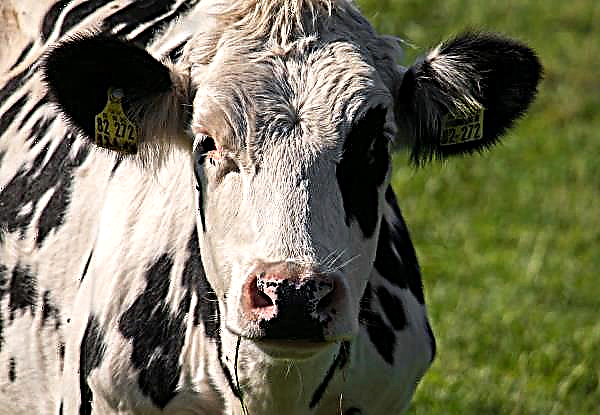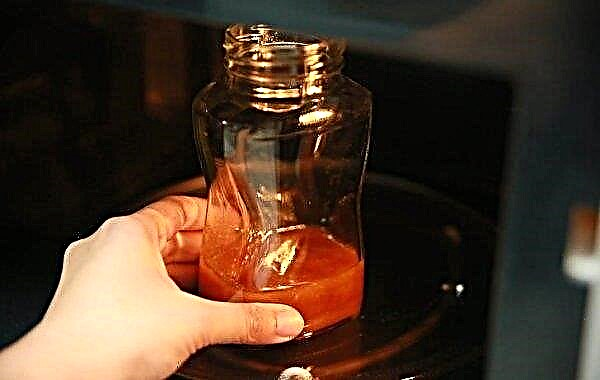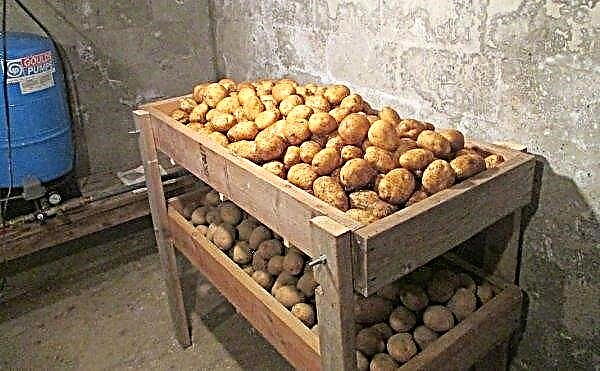When picking potatoes for planting on their own plot, gardeners are forced to take into account several parameters at once - ripening dates, taste, yield, resistance to adverse weather conditions, diseases, pests and others. Potatoes Gala possesses excellent characteristics for almost all of these indicators. What this variety is, what are its advantages and the main features of growing will be discussed in this review.
Did you know? Today, NASA is very active in experiments on growing vegetables in space, but few people know that the first such experiment was carried out almost a quarter century ago, and it was potatoes that became the subject of agronomic efforts of the astronauts.
Description and characteristics of the variety
Gala owes its appearance to the work of German breeders who managed to produce many valuable varieties of potatoes. In Germany, Gala has been known since the “zero” years of this century, but in Russia and other countries of the former CIS this variety appeared only in 2008. At the same time, both farmers and owners of private household plots very quickly appreciated the novelty. Due to its good frost resistance, the variety is excellent for cultivation both in the central and northern regions of the middle lane, as well as in the Urals, the Far East and Siberia. However, if we talk about Russia, then the most popular Gala enjoys among residents of the Leningrad, Kaliningrad, Volgograd, Pskov and Yaroslavl regions.
Due to its good frost resistance, the variety is excellent for cultivation both in the central and northern regions of the middle lane, as well as in the Urals, the Far East and Siberia. However, if we talk about Russia, then the most popular Gala enjoys among residents of the Leningrad, Kaliningrad, Volgograd, Pskov and Yaroslavl regions.
Advantages and disadvantages
- Among the features of Gala, which distinguishes it from other varieties of potatoes, are usually called:
- short ripening;
- resistance to spring cooling;
- wide regionalization region (can be grown in different climatic conditions);
- low requirements for soil composition;
- the correct form of tubers and their identical sizes;
- high commercial quality of potatoes (the percentage of marketable tubers reaches 97%);
- resistance to mechanical damage;
- good indicators of portability and durability;
- very high and friendly productivity;
- excellent taste;
- low starch content (11–13%);
- a combination of friability with a lack of tendency to digest;
- resistance to pests (primarily nematodes), as well as some fungal and viral diseases.
- Gala has a few shortcomings. These include, in particular:
- lack of drought tolerance;
- low resistance to rhizoctonia;
- lack of resistance to twisting of leaves and late blight.
Productivity and ripening dates
Gala refers to mid-early varieties with high yields. Root crops ripen in 70–80 days from the moment of planting tubers laying in the soil. Yield indicators depend on many factors, including the quality of the seed material, soil condition, climatic conditions, agricultural cultivation techniques, but on average an ordinary gardener can expect to dig two to two and a half dozen potatoes from each hole in the fall.
Important! In 2013, Gala confidently entered the top ten best-selling varieties throughout the Russian Federation.
Considering that the average size of tubers in this variety is from 70 to 140 g, we get a very impressive result - 1.5-3.5 kg per bush. When cultivating the Gala variety in large areas using modern agricultural techniques, the farmer can expect to receive such crops, depending on whether we are talking about young potatoes or root crops that have reached full technical maturity:
| Harvesting period | Maximum yield from 100 square meters. m sown area, kg |
| 40 days from planting (new potatoes) | 170 |
| 70–80 days after planting | 700 |
| Average grades | 400 |
Taste qualities
Gala refers to table potato varieties. The low starch content of the tubers means that they are more suitable for boiling than for frying. During cooking, the potato retains its integrity, while becoming tender and crumbly, making it equally good for making mashed potatoes, and for soups or salads. In addition, Galu can be successfully baked. Experts define the taste qualities of tubers with delicate pulp of a light yellow hue as very high: the tasting assessment of root crops on a ten-point scale, according to various sources, ranges from 8 to 9.
Optimal time for landing
Linking the planting dates to a specific calendar date, as, unfortunately, many gardeners practice, is completely wrong. Weather is an unstable phenomenon, it can vary greatly from year to year, therefore the traditionally accepted period “beginning of May” in some cases may be very early, in others, on the contrary, belated. In addition, different climatic zones have their own characteristics. Meanwhile, the wrong time for planting potatoes is minus 20% of the future harvest.
Important! The national calendar says that potatoes can be planted as soon as the first leaves appear on the birch, and you need to finish the process by the time the bird cherry blossoms.
There are four criteria that you need to focus on:
- The soil must be warm and not on the surface, but at the depth at which the tuber is laid (about 10 cm). A planted root crop should be at a temperature of at least + 8 ° C, otherwise it will not be able to develop normally.
- The weather forecast should not portend frost, that after active spring warming happens very often, so you should not rush.
- Water after melting snow should already be absorbed into the soil and evaporate: excess moisture of the earth will cause the planted potato to simply rot.
- Dry soil is also harmful to the plant, as well as excessively wet. At the beginning of the growing season, drought is especially dangerous for Gala, so it is important to find the optimal state between the mud and the dried earth lump.
For those who prefer to focus on the usual calendar, you can advise you to proceed from such approximate dates for planting potatoes, depending on the climatic zone:
| Region | Recommended planting dates for early potato varieties |
| Southern regions of Ukraine, Krasnodar Territory | March 20-30 |
| Central and northern regions of Ukraine, the middle belt of the European part of Russia, Belarus | April 20-30 |
| Ural, Siberia, Far East | May 10–20 |
Planting and growing potato varieties
Planting potatoes is a complex science in which determining the optimal timing is just one of the sections. In addition, in order to receive the harvest of the Gala promised by German breeders, a whole series of conditions must be observed.
Crop rotation rules
Crop rotation is an alternation of different crops grown from year to year on the same bed, which ensures the achievement of maximum yields.
This result is possible due to the fact that the change of plants similar in developmental features does not allow to increase the population of pests that persist in the soil and parasitize on certain crops, as well as to critically reduce certain mineral substances in it, to which such crops are especially demanding.
Moreover, there are plants that secrete substances during their life that are toxic to their "host", but very useful for other crops. Knowing these rules allows you to determine the good and bad predecessors for each plant.
Did you know? French fries, like many other world-famous dishes, were invented by chance, and not thanks to the talent of the chef, but rather in spite of him. In 1853, the chef of one of the American restaurants, George Crum, was angry at the fastidious visitor who complained about being too thickly cut fried potatoes, cut the vegetable with subtle slices and, frying, served it to the brawler, which unexpectedly led him into complete delight.
For potatoes (regardless of variety) they are as follows:
- Good predecessors:
- Siderata;
- Oats;
- Cucumbers
- Zucchini;
- Pumpkin;
- Cabbage;
- Bow;
- Beet;
- Carrot;
- Garlic;
- Beans
- Peas;
- Lentils
- Bad predecessors:
- Potatoes;
- Tomatoes
- Bell pepper;
- Hot pepper;
- Eggplant
- Tobacco;
- Physalis;
- Sorghum;
- Sunflower.
Land requirements
The worst potato grows on heavy soils, in particular chernozem and alumina. Such soil, among other things, greatly complicates the maintenance of plantations and significantly increases losses during harvesting, so it is advisable to plant Gala on light and loose soils, for which, if necessary, sand, peat, wood ash, sawdust can be added to it.
But on sandy and loamy soils, Gala will feel perfect. Potatoes also react poorly to strongly acidified or alkaline soil. This crop needs soil with a neutral or slightly acidic reaction (pH level in the range 5.1–6.0).
Preparing planting material
For planting, it is best to select potatoes, guided by four basic rules:
- The average size is 5–6 cm in diameter (the size of a chicken egg). Potatoes that are too small will produce the same modest yield, large root crops can be planted, but they will need to be purchased by weight more, and the costs will not justify themselves.
- The absence of any damage, including cracks, cuts or traces of the disease (to consider that sick potatoes cannot be eaten, but can be planted is a big mistake).
- The correct form and structure: the skin should be smooth and strong, not wrinkled, but absolutely dry.
- Lack of sprouts. Germination of potatoes before planting is a desirable procedure, but you need to do this yourself. By purchasing tubers with sprouts, the gardener runs the risk of damaging them during transport, and crop yields are severely affected.
Did you know? We are used to perceive potatoes as a low annual herbaceous plant, but in the tropical forests you can find this crop in the form of a real tree 15 meters high and fruits the size of an average tomato.
There are two ways to sprout potatoes:
- dry - place in plastic bags with holes made in advance and put in a warm place (optimum temperature + 20 ° С) for 3-4 weeks;
- wet - immerse for the same period in boxes with moistened sand, peat or wood chips, however, in this case, the air temperature should be lower - approximately + 14 ... + 16 ° С.
 Having a good germination ability, Galu can be planted without germination. In this case, it is only necessary to warm it up well, laying out 4-5 days before planting in a well-warmed place. To improve rooting and disinfection, soak prepared tubers immediately before planting for 30 minutes in special preparations such as Maxim, Bunker or Tabu.
Having a good germination ability, Galu can be planted without germination. In this case, it is only necessary to warm it up well, laying out 4-5 days before planting in a well-warmed place. To improve rooting and disinfection, soak prepared tubers immediately before planting for 30 minutes in special preparations such as Maxim, Bunker or Tabu.Step-by-step landing instructions
If potatoes are planted manually, proceed as follows:
- Before embarking, it is necessary to carefully dig a plot to a depth of about 20 cm ("on the bayonet of a shovel").
- The next, very important point is the marking of future beds. Between rows it is necessary to leave at least 60 cm, this is necessary not only for the normal development of each bush, but also to facilitate future harvesting (dug potatoes before packing and loading need to be stored somewhere, and wide aisles are necessary for these purposes).
- In accordance with the marking made, ditches should be dug with a depth of about 10 cm. The minimum distance between the holes in the row is 20 cm.
- If the soil is too poor, the pits should be made deeper, up to 15 cm, and then organic and mineral fertilizers should be laid in them according to the following scheme: organic matter (manure, compost, humus) is placed in the center of the pit, and mineral fertilizers (for example, nitrofosk in a dosage of 8 –10 g per bush) - around the circumference at a distance of 3-4 cm from the center). A layer of loose earth should be added over fertilizers, thus bringing the depth of the hole to the required 10 cm.
- Place the prepared potato in the center of the hole.
- Cover the hole with earth.
Video: planting potatoes
On too wet and boggy soils, a special method of planting potatoes is used - “on the comb”. In order for the tubers not to rot and not suffer from fungal infections actively developing in the humid environment, planting potatoes should be placed as high as possible. To do this, the tubers are laid out on top of an earthen hill, removed from the bed when digging a hole, and for taking potatoes to fall, earth taken from a nearby site is used.
In fact, such a landing involves digging not individual holes, but a continuous trench, as a result of which the same ridge is formed on one side of it. The planting procedure in this way is more time-consuming, but this work is due to objective necessity in an area unfavorable for potatoes.
Potato care after planting
Gala is an unpretentious and hardy variety, but in order to get a good harvest for a potato plantation, it is necessary to provide good care. In this case, the standard rules apply, which must be observed when growing any potato, namely, hilling, watering, top dressing.
Hilling and loosening the soil
Hilling is a special agrotechnical technique that involves heaping around the lower part of the plant an additional layer of loose and fertile soil. This trick stimulates the development of the root system of the bush, due to which the amount of nutrients that the plant can get from the soil increases. In addition, a bush with powerful roots forms a more stable and strong stem. This means that the process of photosynthesis necessary for the formation of the maximum number of root crops also proceeds more intensively. An additional advantage of hilling is the protection of planting material from possible spring cooling, as well as the enrichment of the soil with oxygen. Finally, such a manipulation allows you to get rid of the main pests of the garden - weeds.
This means that the process of photosynthesis necessary for the formation of the maximum number of root crops also proceeds more intensively. An additional advantage of hilling is the protection of planting material from possible spring cooling, as well as the enrichment of the soil with oxygen. Finally, such a manipulation allows you to get rid of the main pests of the garden - weeds.
Important! It is estimated that correctly carried out hilling allows increasing potato yield by 20–30%.
It is recommended to spud potatoes at least twice during the growing season. The first time the procedure is carried out when young seedlings grow by 15–20 cm, while the height of the mound around the bush should be small - only 2-3 cm. The second hilling is carried out 2-3 weeks after the first, when the plant has already reached its usual size. This time, the height of the earthen hill needs to be increased so that 15-17 cm of the stem rises above the ground.
If the potato bed is spudding, there is no need to loosen the earth additionally, all necessary actions will be carried out at the time of construction of the hills around the bush. However, not all gardeners resort to hilling. For those who prefer to leave the bed under the potatoes even, it is necessary to carefully after each rain or watering, trying not to damage the roots of the plant, loosen the earth around each bush, this will protect it from cracking and preserve life-giving moisture.
Watering and fertilizing
Gala's drought tolerance is not very high, therefore, compliance with the irrigation regime is an important condition for obtaining a good harvest. Potato moisture requirements change during the season and vegetation phase. Root crops are laid between the beginning of flowering and the completion of bush growth.It was at this time that drought was especially dangerous for the plant: the more it suffers from a lack of moisture, the less tubers will be dug up in the fall.
Did you know? Each kilogram of dry matter in tubers requires an average of half a ton of water, with each potato bush evaporating up to 70 liters of water during the season!
However, despite the aforesaid, in some cases, Galu can be successfully grown with little or no watering, it all depends on the initial soil moisture, which is largely maintained by loosening; it is not without reason that this procedure is often called “dry watering”. But as the beds dry to a depth of 5 cm or more, it must be watered, guided by such "golden" rules:
- moistening of the earth should be uniform (if drought in the garden alternates with waterlogging, tubers grow ugly and deformed);
- the average water consumption per bush is 2 l (less water is required on loamy and peaty soils, more is more on sandy soils);
- during the day you can water the garden only when using the drip irrigation system, in all other cases it is better to carry out the procedure in the evening (dropping water on sunlit leaves is a direct way not only to burn, but also to damage the bush with late blight);
- watering potatoes on a leaf is occasionally allowed, but it is best to pour water into the furrows between the beds.
 Since Gala belongs to the potato varieties of early ripening, it is enough to feed the plant only once per season (provided, of course, that the necessary amount of organic and mineral fertilizers was applied to the soil before planting or even earlier, in the autumn preparation of the site). simultaneously with the second hilling, that is, in the middle of the growing season.
Since Gala belongs to the potato varieties of early ripening, it is enough to feed the plant only once per season (provided, of course, that the necessary amount of organic and mineral fertilizers was applied to the soil before planting or even earlier, in the autumn preparation of the site). simultaneously with the second hilling, that is, in the middle of the growing season.To do this, use:
- organics, for example, chicken droppings or mullens, diluted in water at a concentration of 1:10 and 1: 5, respectively;
- mineral fertilizers, for example, 3 tbsp. l wood ash + 1 tbsp. potassium sulfate per 10 liters of water.
Important! Before applying fertilizer, the bed must be watered.
Potato diseases and pests
Of the most dangerous diseases affecting potatoes, Gala most often suffers from rhizoctonia, also known as black scab. The disease is characterized by the appearance of a dark coating on the stems and leaves, they become thin, wither and dry. To combat the problem, pre-planting treatment of tubers is carried out, and if this measure does not give a result, the bed should be treated with a fungicidal preparation ("Quadris", "Bactofit", etc.).
The same measures can defeat another fungal disease - late blight. However, Gala is more resistant to it, mainly due to the early ripening period (phytophthora activation usually occurs in the middle of summer, when the Gala harvest is already taken). Sometimes on the bushes of Gala you can observe twisting of leaves. After a while, the leaf plate withers and dries out, and on the tubers you can observe a dark necrotic mesh. These symptoms characterize rustling mosaic - a disease of a viral nature and not having effective treatment methods. You can deal with the problem only with preventive measures - observe crop rotation rules, get rid of weeds, remove affected specimens from the beds and destroy them immediately.
Sometimes on the bushes of Gala you can observe twisting of leaves. After a while, the leaf plate withers and dries out, and on the tubers you can observe a dark necrotic mesh. These symptoms characterize rustling mosaic - a disease of a viral nature and not having effective treatment methods. You can deal with the problem only with preventive measures - observe crop rotation rules, get rid of weeds, remove affected specimens from the beds and destroy them immediately.
Among the pests that can attack the potato bed, the first thing to do is:
To combat them, insecticidal drugs are used, for example, Actellik, Vertimek, Decis, etc. As an alternative to chemical poisons that adversely affect the ecology and nutritional value of the potato itself, modern science offers biological products that are best known among which are Fitosporin, Baciturin, Fitoverm, Lepidocide and Melobass. Many beginning gardeners are very worried if the potatoes on their beds do not bloom, mistakenly believing that this indicates a plant disease and will subsequently lead to a lack of harvest.
Did you know? Potato bloom does not directly affect the formation of fruits, moreover, there are varieties of this culture, for example, Arina, Early Rose, Priekulsky, etc., in which there are practically no flowers.
In fact, this is not so. The answer to the question why an apparently healthy potato bush does not have bud budding most often lies in the plane of the correct ratio of minerals in the soil, in particular, this happens with an excess of nitrogen and a deficiency of phosphorus or potassium. But picking buds from the bush, as some summer residents do, should not be done either: the development of the plant should take place naturally, if flowering has begun, it does not need to be disturbed, this, indeed, can adversely affect the formation of tubers.
Features of harvesting and storage of crops
Gala belongs to the early ripe varieties of potatoes, its tubers fully ripen in about 2.5 months after planting. This feature allows you to take several crops in one and the same plot during the season, however, only residents of the southern regions can achieve this result, where steadily warm weather lasts at least from early May to late September. You can start digging up young potatoes as soon as the plant fades, that is, already in early summer. As for fully ripened root crops, it is necessary to focus on the condition of the bush. Choosing the right time to pick potatoes is not an easy task, but preserving the crop directly depends on its successful solution. We must try to choose dry weather for these works, otherwise the root crops extracted from the earth will quickly begin to rot. In addition, harvesting must be completed before the first frost. The minimum allowable average daily temperature at which tubers can remain in the ground is + 5 ° C. 7-10 days before digging potatoes, it is necessary to completely remove from the field the remains of the tops - green or dry.
Choosing the right time to pick potatoes is not an easy task, but preserving the crop directly depends on its successful solution. We must try to choose dry weather for these works, otherwise the root crops extracted from the earth will quickly begin to rot. In addition, harvesting must be completed before the first frost. The minimum allowable average daily temperature at which tubers can remain in the ground is + 5 ° C. 7-10 days before digging potatoes, it is necessary to completely remove from the field the remains of the tops - green or dry.
Important! The biological maturity of the tubers occurs at the moment when the aerial part of the plant dries out naturally. However, experts recommend mowing potato tops a little earlier, while it is still green, and then allowing the crop to remain in the ground for a while, so the peel of root crops becomes stronger, and their durability is significantly improved.
Gala is generally well tolerated and suitable for long-term storage. Moreover, the strong and fairly thick peel, the correct shape, and also approximately the same size of tubers of this variety allow manipulations with potatoes such as repeated packaging and washing before selling (Gala is most often used in supermarkets for sale in washed form at a higher price).
In order to extend the shelf life of the crop and preserve its commercial qualities until the very spring, preventive treatment (soaking) of tubers with antifungal drugs is practiced before laying potatoes in storage. For these purposes, drugs such as Bactofit or Maxim are usually used. Potato Gala is a wonderful choice for both professional farmers and those who grow vegetables for their own consumption. Due to its early maturity, high productivity, excellent taste and strong immunity, this product of the work of German breeders over its short history has managed to gain immense popularity not only in its homeland, but also far beyond its borders.
Potato Gala is a wonderful choice for both professional farmers and those who grow vegetables for their own consumption. Due to its early maturity, high productivity, excellent taste and strong immunity, this product of the work of German breeders over its short history has managed to gain immense popularity not only in its homeland, but also far beyond its borders.

